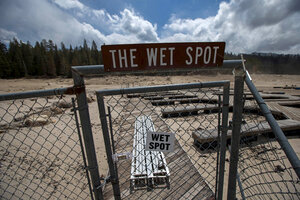California drought: State's water restrictions face court tests
Four lawsuits over restrictions for 'senior' water users in the Sacramento and San Joaquin River watersheds, as well as a lawsuit by the city of Riverside, challenge state control over local water rights amid the California drought.

A record-breaking drought in California has led to dried-up lakes and reservoirs, as well as resistance to new water restrictions.
Lucy Nicholson/File/Reuters
Four years into a record-breaking drought, California is suddenly awash in lawsuits challenging the state's water-saving directives, especially the 25 percent mandatory statewide cutbacks ordered by Democratic Gov. Jerry Brown.
Less than a month after those mandatory restrictions went into effect, one city about 50 miles east of Los Angeles is the first municipality to challenge state control over local water rights in the courts.
Riverside is suing the state, claiming that the new restrictions unfairly affect the community. Under the new regulations, Riverside can face fines of up to $10,000 a day if it doesn’t cut water use over the next nine months by 24 percent, compared with levels in 2013, reported public radio station KPCC.
Lawyers for the city say that Riverside should qualify under the “reserve tier,” which requires only a 4 percent cut in water use.
The State Water Resources Control Board designated the reserve tier for water districts that could draw on surface-level water resources, like lakes and streams, while also having a four-year reserve supply. Riverside argues that it has a four-year reserve that comes from its local groundwater aquifers.
State officials say they did not include groundwater in the original exemption because of difficulties in reliably measuring groundwater levels, and the use of groundwater reserves as an emergency resource.
Riverside may be the first city to sue the state based on this round of water cutbacks, but other policies coming from the state government have already sparked legal action, especially in California’s busy farming regions.
Some 40 percent of the state's water use goes to agriculture, which grossed nearly $50 billion in 2013, but even this economic breadbasket has had to turn down the spigot. In response, some water users are making their case in court.
Rights to surface water in California are governed by an arcane system that assigns priority for water use based on when districts or users began diverting water. Senior users – that is, those who diverted water before the state began regulating water rights in 1914 – are typically the last to be cut off in times of drought.
But on June 19, the Water Resources Control Board tapped senior water-rights holders for the first time since the drought of 1977. And a group of water districts filed a complaint over an order that stopped 114 water-rights holders from legally drawing from the Sacramento and San Joaquin River watersheds.
“The state didn’t do any due process. They didn’t hold a hearing of any kind,” Jeff Shields, general manager of the South San Joaquin Irrigation District, told The Sacramento Bee. "The Constitution provides protections for private property, and there’s a due process that one has to go through to take that property.”
Some critics have suggested overhauling the current water-rights system to make it more equitable, but UC Berkeley environmental law professor Holly Doremus says that option is unlikely.
"I don't think the water-rights system is going to be blown up this year or anytime soon," Professor Doremus told the Los Angeles Times.
As it stands, four lawsuits have been filed against the state over the reduction of senior water rights.
The state water board has indicated that citizens should brace for further curtailments and reductions, while the board itself braces for more litigation.
“These are very difficult times, and everyone, urban and rural, will have to make sacrifices as we go through them,” said the board's chair, Felicia Marcus, in a statement.
[Correction: This article has been updated to correct the total percentage of water used by agriculture in California.]

